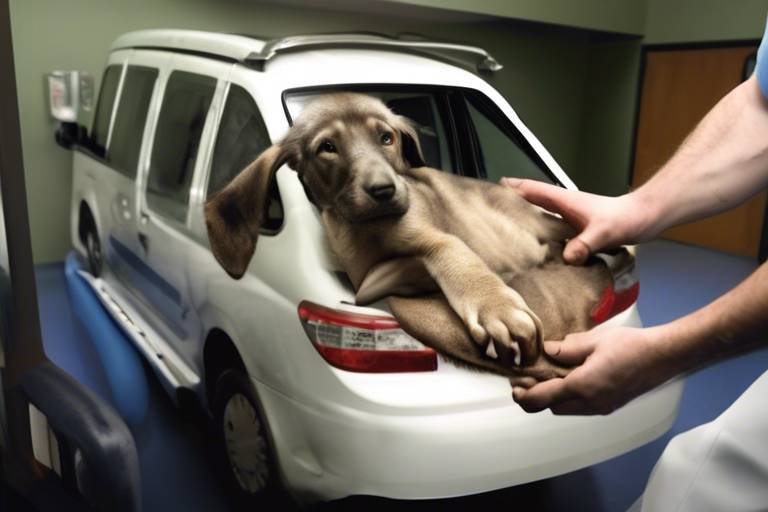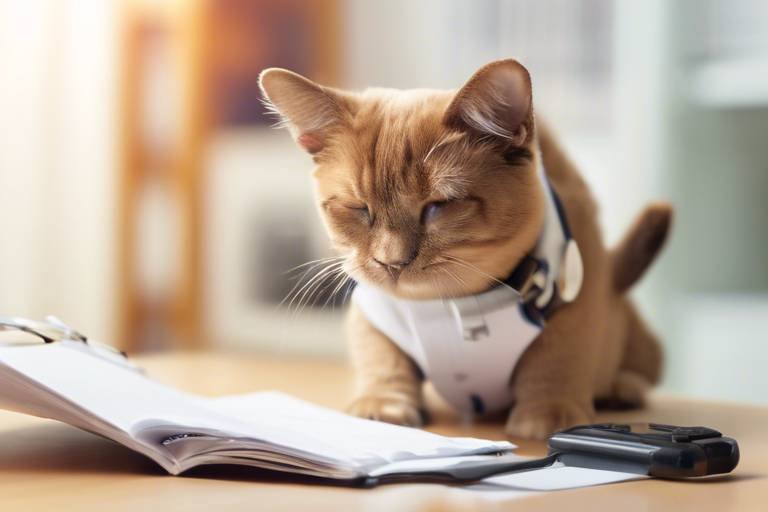What to Do If Your Pet Is Experiencing Abdominal Pain
As a pet owner, there's nothing quite as distressing as seeing your furry friend in discomfort. When it comes to abdominal pain, recognizing the signs and taking prompt action can make all the difference. Imagine your pet, usually full of energy and joy, suddenly becoming lethargic and withdrawn. It's heartbreaking, isn't it? Understanding how to identify abdominal pain in your pet is crucial for ensuring their health and happiness. This article will guide you through the symptoms to watch for, common causes of abdominal pain, and the steps you should take to help your beloved animal.
First things first, how do you know if your pet is in pain? Animals are masters at hiding discomfort, but there are some key signs you can look for. Common symptoms of abdominal pain include:
- Vomiting: Frequent vomiting can indicate a problem.
- Lethargy: If your pet is unusually tired or less active, it could be a sign of pain.
- Changes in appetite: A sudden decrease or increase in appetite might signal an issue.
- Behavioral changes: Watch for signs of distress, such as whining or hiding.
Being vigilant and observing these symptoms closely can help you act quickly and seek veterinary assistance when necessary. Remember, early intervention can prevent more serious health issues down the line.
Now that you know how to recognize the symptoms, let's delve into what might be causing your pet's discomfort. Abdominal pain can stem from a variety of issues, including:
- Gastrointestinal disorders
- Infections
- Foreign objects
Identifying the root cause is essential for effective treatment and recovery. Let's explore some common causes in more detail.
Conditions like gastritis, pancreatitis, or intestinal blockages can lead to severe abdominal pain. For instance, gastritis, which is an inflammation of the stomach lining, can cause nausea and vomiting. On the other hand, pancreatitis can lead to severe abdominal pain and may require hospitalization. Recognizing these issues early can help prevent complications and ensure your pet receives the appropriate care.
Pets are notorious for their curious nature, often ingesting inappropriate items or foods that can upset their stomachs. This phenomenon, known as dietary indiscretion, can lead to discomfort and pain. For example, if your dog sneaks a whole pizza off the counter, you might find them in distress later. Understanding dietary indiscretion can help prevent future incidents and maintain your pet's digestive health.
Infections or inflammatory conditions in the abdomen, such as peritonitis, can cause significant discomfort. These conditions can arise from various sources, including bacterial infections or injuries. Being aware of these conditions can prompt quicker veterinary intervention, which is vital for your pet's recovery.
Physical injuries or trauma to the abdomen can also lead to pain and discomfort. For example, if your pet has been in a fight or had a fall, it’s crucial to assess them for any signs of injury. Look for swelling, bruising, or tenderness in the abdominal area. Understanding how to assess your pet after an injury is vital for ensuring their safety and well-being.
Knowing when to consult a veterinarian is essential for your pet's health. If your pet shows any of the symptoms mentioned earlier, especially if they worsen or do not improve within a short period, it’s time to act. Immediate veterinary attention is required if you notice:
- Severe vomiting
- Blood in the stool
- Signs of shock
Recognizing these signs can save your pet's life and ensure prompt treatment. Don't hesitate; your pet relies on you to make the right call.
In emergencies, time is of the essence. If your pet exhibits any alarming symptoms, such as those listed above, rush them to the vet immediately. It's better to be safe than sorry when it comes to your furry friend's health.
After your pet has received initial treatment, monitoring their recovery is crucial. Regular follow-ups with your veterinarian can help track progress and adjust treatment plans as necessary. Keep an eye on their eating habits, energy levels, and overall behavior. Your vigilance can make a significant difference in their recovery journey.
Q: What should I do if my pet is vomiting?
A: If your pet is vomiting, monitor them closely. If it persists for more than a few hours or is accompanied by other symptoms, contact your veterinarian.
Q: Can I give my pet over-the-counter medications for pain?
A: Never give your pet over-the-counter medications without consulting a veterinarian, as many human medications can be toxic to animals.
Q: How can I prevent abdominal pain in my pet?
A: Preventing abdominal pain involves ensuring your pet has a balanced diet, regular exercise, and avoiding access to harmful items they might ingest.

Recognizing Symptoms of Abdominal Pain
This article provides guidance for pet owners on identifying and addressing abdominal pain in pets, including signs to watch for, potential causes, and when to seek veterinary assistance.
Understanding the signs of abdominal pain in pets is crucial for timely intervention. Pets can’t speak up about their discomfort, so it falls on us to be their voice. Have you ever noticed your furry friend acting a little off? Maybe they’re not their usual playful selves, or perhaps they’re hiding away instead of lounging next to you. These subtle changes can be your first clue that something isn’t right. Common symptoms of abdominal pain in pets include:
- Vomiting: Frequent vomiting can indicate a serious issue. If your pet is throwing up more than once, it’s time to pay close attention.
- Lethargy: If your pet seems unusually tired or disinterested in their favorite activities, it could be a sign of pain.
- Changes in Appetite: Is your pet refusing to eat or drinking excessively? These changes can signal underlying health issues.
- Behavioral Changes: Watch for signs of distress, such as whining, pacing, or hiding. These behaviors can indicate discomfort.
It’s essential to monitor these symptoms closely. For instance, if your dog suddenly refuses to chase their ball or your cat is no longer interested in their treats, it might be time to investigate further. Remember, pets are masters at hiding pain, so any noticeable change in their behavior should be taken seriously.
In addition to the above symptoms, you might observe physical signs like a distended belly or excessive drooling. If you notice your pet’s abdomen feels tense or is visibly swollen, this could indicate a serious condition that requires immediate veterinary attention. It's always better to err on the side of caution—when in doubt, reach out to your vet!
As a pet owner, being vigilant about your pet's health means you can catch potential issues before they escalate. Think of it like being a detective; you’re looking for clues in their behavior and physical state. If you suspect your pet is in pain, don’t hesitate to consult your veterinarian. They can provide the necessary examinations and diagnostics to determine the root cause of the discomfort.
Abdominal pain in pets can arise from various issues, including gastrointestinal disorders, infections, or even foreign objects. Identifying the root cause is essential for effective treatment and recovery.
Conditions such as gastritis, pancreatitis, or intestinal blockages can lead to severe abdominal pain. Recognizing these issues early can help prevent complications and ensure your pet receives the appropriate care.
Pets often ingest inappropriate items or foods that can upset their stomachs. Understanding dietary indiscretion can help prevent future incidents and maintain your pet's digestive health.
Infections or inflammatory conditions in the abdomen, such as peritonitis, can cause significant discomfort. Awareness of these conditions can prompt quicker veterinary intervention.
Physical injuries or trauma to the abdomen can lead to pain and discomfort. Understanding how to assess your pet after an injury is vital for ensuring their safety and well-being.
Knowing when to consult a veterinarian is essential for your pet's health. Immediate veterinary attention is required if symptoms worsen or do not improve within a short period.
Certain signs, such as severe vomiting, blood in the stool, or signs of shock, indicate an emergency. Recognizing these signs can save your pet's life and ensure prompt treatment.
After initial treatment, monitoring your pet's recovery is crucial. Regular follow-ups with your veterinarian can help track progress and adjust treatment plans as necessary.
Q: What should I do if I suspect my pet has abdominal pain?
A: Monitor their symptoms closely and consult your veterinarian if you notice significant changes in behavior, appetite, or physical condition.
Q: Are there any home remedies for pet abdominal pain?
A: While some mild digestive issues may be managed at home, it's essential to consult with your vet before administering any treatment.
Q: How can I prevent abdominal pain in my pet?
A: Ensure your pet has a balanced diet, avoid giving them table scraps, and keep potentially harmful items out of reach.

Common Causes of Abdominal Pain
Abdominal pain in pets can stem from a variety of sources, and understanding these can be a game changer for your furry friend’s health. Imagine your pet as a delicate machine; when one part malfunctions, the whole system can start to fail. This is why recognizing the common causes of abdominal pain is essential for any pet owner. Whether it's something as simple as a dietary indiscretion or as serious as an internal infection, being aware of the potential issues can lead to quicker intervention and better outcomes.
One of the most frequent culprits behind abdominal pain is gastrointestinal issues. Conditions like gastritis, pancreatitis, or intestinal blockages can wreak havoc on your pet's digestive system. For instance, gastritis, which is the inflammation of the stomach lining, can cause your pet to feel nauseous, leading to vomiting and discomfort. Similarly, pancreatitis, an inflammation of the pancreas, can result in severe pain and requires immediate veterinary attention. If your pet is exhibiting signs like refusing food or acting restless, it could be a sign of these gastrointestinal problems.
Another cause that often goes unnoticed is dietary indiscretion. Pets are notorious for their curious nature, and sometimes that curiosity leads them to munch on things they shouldn’t—think of it as a toddler discovering candy in a cupboard. Eating inappropriate items, such as spoiled food, table scraps, or even non-food items like toys, can upset their stomachs and lead to abdominal pain. Keeping a close eye on what your pet has access to can help mitigate these issues. If you suspect your pet has indulged in something they shouldn't have, monitor them closely for any signs of distress.
Infections and inflammation also play a significant role in causing abdominal pain. Conditions like peritonitis, which is an inflammation of the lining of the abdominal cavity, can be particularly dangerous. This condition can arise from bacterial infections, and it often presents with severe symptoms like fever, vomiting, and lethargy. If your pet is showing signs of discomfort and you suspect an infection, it’s crucial to seek veterinary help promptly. The sooner you act, the better the chances of a full recovery.
Lastly, don't overlook the possibility of trauma and injury as causes of abdominal pain. Pets can be playful and sometimes reckless, leading to injuries that may not be immediately apparent. A sudden fall, a rough play session, or even a car accident can lead to internal injuries that cause significant pain. If you notice your pet acting unusually after an accident, assess them for any signs of discomfort or pain. It’s always better to be safe than sorry, and a quick trip to the vet can rule out any serious issues.
| Cause | Symptoms | Recommended Action |
|---|---|---|
| Gastrointestinal Issues | Vomiting, lethargy, loss of appetite | Consult a veterinarian immediately |
| Dietary Indiscretion | Diarrhea, vomiting, bloating | Monitor closely and seek vet advice if symptoms persist |
| Infections/Inflammation | Fever, vomiting, abdominal tenderness | Immediate veterinary care required |
| Trauma/Injury | Unusual behavior, reluctance to move, whining | Assess and seek veterinary help if needed |
Gastrointestinal Issues
Gastrointestinal issues can be a significant source of discomfort for our furry friends, often leading to severe abdominal pain. Conditions such as gastritis, pancreatitis, and intestinal blockages are common culprits that can cause your pet to experience distress. It's essential to recognize these issues early, as timely intervention can prevent complications and ensure your pet receives the appropriate care.
Gastritis, for instance, is the inflammation of the stomach lining and can be triggered by various factors, including dietary indiscretion or infections. Symptoms may include vomiting, diarrhea, and a lack of appetite. If your pet is showing these signs, it's crucial to consult your veterinarian as soon as possible.
Another serious condition is pancreatitis, which occurs when the pancreas becomes inflamed. This can happen due to a high-fat diet or other underlying health issues. Pets suffering from pancreatitis may exhibit symptoms such as severe abdominal pain, lethargy, and even fever. It's like having a storm brewing in their belly, and the only way to calm it is through proper medical care.
Intestinal blockages can occur when a foreign object, such as a toy or a piece of clothing, gets lodged in the intestines. This can lead to a buildup of gas and fluid, causing significant pain and discomfort. Signs of an intestinal blockage include persistent vomiting, lack of bowel movements, and a swollen abdomen. If you suspect your pet has swallowed something they shouldn't have, don't delay in seeking veterinary assistance.
To help illustrate the differences between these gastrointestinal issues, here's a quick comparison table:
| Condition | Symptoms | Causes |
|---|---|---|
| Gastritis | Vomiting, diarrhea, lack of appetite | Dietary indiscretion, infections |
| Pancreatitis | Severe abdominal pain, lethargy, fever | High-fat diet, underlying health issues |
| Intestinal Blockage | Persistent vomiting, lack of bowel movements, swollen abdomen | Foreign objects, tumors |
Understanding these gastrointestinal issues and their symptoms can empower you as a pet owner to act quickly and ensure your beloved pet receives the care they need. Remember, when in doubt, it’s always best to consult with your veterinarian. They can provide the necessary diagnostics and treatments to help your pet feel better.
- What should I do if my pet is vomiting? If your pet is vomiting, monitor them closely. If it persists for more than a few hours or is accompanied by other concerning symptoms, contact your veterinarian.
- Can I treat gastrointestinal issues at home? While some mild cases can be managed at home, it's crucial to consult your veterinarian for proper diagnosis and treatment, especially if symptoms are severe.
- How can I prevent gastrointestinal issues in my pet? Maintaining a balanced diet, avoiding table scraps, and ensuring your pet doesn't ingest foreign objects can significantly reduce the risk of gastrointestinal problems.
Dietary Indiscretion
is a common issue among pets, often leading to abdominal pain and discomfort. This term refers to the tendency of pets to eat things they shouldn't—think of your furry friend as a curious toddler who can't resist exploring the world through their mouth! Whether it’s a forgotten snack on the floor, a tempting piece of trash, or even a strange plant in the garden, pets can easily find themselves in a pickle when it comes to their diet.
When pets indulge in these inappropriate foods or objects, it can result in a range of gastrointestinal problems. For instance, they may experience vomiting, diarrhea, or even more severe conditions like blockages in their intestines. The symptoms can vary from mild to severe, and it’s essential for pet owners to recognize the signs early. If your pet has suddenly lost interest in their food or is acting lethargic, these could be red flags indicating they’ve ingested something that doesn’t agree with them.
One of the most alarming aspects of dietary indiscretion is that it can sometimes lead to emergencies. For example, if a pet swallows a foreign object, this can lead to a blockage, which may require surgical intervention. To put it simply, if you think your pet has eaten something they shouldn’t, it’s better to be safe than sorry. Always consult with your veterinarian if you suspect dietary indiscretion, especially if your pet shows signs of distress.
Preventing dietary indiscretion involves a combination of vigilance and education. Here are a few practical tips for pet owners to minimize the risk:
- Keep trash bins securely closed and out of reach.
- Educate family members about not feeding pets table scraps.
- Provide appropriate toys and treats to satisfy their chewing instincts.
- Regularly check your yard for potentially harmful plants or items.
In conclusion, being proactive about your pet's diet can significantly reduce the risk of dietary indiscretion and its associated complications. By staying alert and informed, you can help ensure your beloved pet maintains a healthy and happy digestive system.
- What are the signs of dietary indiscretion in pets? Common signs include vomiting, diarrhea, lethargy, and changes in appetite.
- What should I do if my pet eats something they shouldn't? Contact your veterinarian immediately for advice tailored to your pet's situation.
- How can I prevent my pet from eating inappropriate items? Secure trash cans, educate family members, and provide appropriate toys and treats.
Infections and Inflammation
Infections and inflammatory conditions in your pet's abdomen can lead to significant discomfort and distress. These issues often stem from a variety of underlying causes, such as bacterial infections, viral infections, or even parasitic infestations. When your furry friend is suffering from an infection, it can be akin to having a storm brewing inside them—chaotic and painful. The inflammation can occur in various organs, including the intestines, liver, or even the lining of the abdominal cavity itself.
One of the most serious conditions related to abdominal inflammation is peritonitis, which is an inflammation of the peritoneum—the lining of the abdominal cavity. This condition can arise from a ruptured organ, such as the intestines or bladder, allowing bacteria and toxins to enter the abdominal cavity, leading to a life-threatening situation. Symptoms of peritonitis can include severe abdominal pain, swelling, fever, and a significant decrease in appetite. If you notice these signs, it's crucial to act quickly, as time can be of the essence.
Other infections may present with similar symptoms but can be attributed to different causes. For instance, pancreatitis, an inflammation of the pancreas, can lead to abdominal pain as well as vomiting and lethargy. The causes of pancreatitis can vary widely, often linked to dietary indiscretions or underlying health issues. It's essential to recognize that different types of infections can require different treatment approaches, and a veterinary examination is necessary for accurate diagnosis and effective treatment.
In addition to recognizing the symptoms, it’s important to understand the potential sources of these infections. Some common causes include:
- Bacterial Infections: These can occur after trauma or surgery, or due to underlying health issues.
- Viral Infections: Certain viruses can cause gastrointestinal inflammation, leading to discomfort and pain.
- Parasites: Intestinal parasites can provoke inflammation and lead to abdominal pain.
Understanding the signs of infections and inflammation in your pet is crucial because early intervention can significantly improve the outcome. If your pet exhibits any of the symptoms mentioned, don’t hesitate to contact your veterinarian. They can perform necessary diagnostic tests, such as blood work or imaging, to determine the exact nature of the problem and initiate the appropriate treatment. Remember, your pet relies on you to be their voice and advocate, especially when they are feeling under the weather.
Common signs include vomiting, diarrhea, lethargy, loss of appetite, and abdominal swelling or pain. If you notice any of these symptoms, it's important to seek veterinary care.
Regular veterinary check-ups, vaccinations, and maintaining a balanced diet can help prevent infections. Additionally, keep your pet away from potentially harmful substances and environments.
If your pet shows signs of severe abdominal pain, such as crying, inability to find a comfortable position, or if symptoms worsen, you should seek veterinary care immediately.
Trauma and Injury
When it comes to our beloved pets, their safety is a top priority, and understanding how to assess trauma and injury is crucial for every pet owner. Imagine your furry friend as a small child—curious and often unaware of the dangers that lurk around them. Pets can easily get into scrapes, whether it's a playful tumble down the stairs or a rough encounter with another animal. Recognizing the signs of trauma is vital because, unlike us, animals can't vocalize their pain. Instead, they may exhibit subtle changes in behavior that could indicate something is seriously wrong.
Common signs of trauma in pets include:
- Unusual vocalizations such as whimpering or growling
- Changes in mobility, like limping or reluctance to move
- Swelling or bruising in any area of the body
- Excessive panting or signs of distress
If you observe any of these symptoms, it's essential to act quickly. Just like a detective piecing together clues, you should assess the situation methodically. Begin by checking for visible injuries, such as cuts or swelling. If your pet is in pain, they may react defensively, so approach them with caution. Sometimes, the injury may not be immediately visible, especially if it involves internal organs or fractures. In such cases, monitoring their behavior closely becomes even more critical.
Injuries can stem from various sources, including:
- Accidental falls from heights or during play
- Fights with other animals, leading to bites or scratches
- Automobile accidents, which can cause severe trauma
After assessing your pet, if you suspect a serious injury, it's time to consult your veterinarian. They have the expertise to diagnose and treat injuries that may not be apparent to the untrained eye. Remember, delaying care can lead to complications, much like ignoring a small crack in a dam until it bursts. Prompt veterinary attention can make all the difference in your pet's recovery.
In the event of a trauma, your vet may recommend a series of diagnostic tests, including X-rays or ultrasounds, to determine the extent of the injury. Based on the findings, treatment options may vary from pain management and rest to more invasive procedures like surgery. It's essential to follow your vet's advice closely, as proper follow-up care is crucial for a full recovery. Just as we would after a significant injury, your pet will need time to heal, and monitoring their progress will help ensure they return to their playful selves.
Q: How can I tell if my pet is in pain?
A: Signs of pain in pets can include vocalizations, changes in behavior, reluctance to move, and unusual postures. If you suspect pain, it's best to consult your veterinarian.
Q: What should I do if my pet has a visible injury?
A: Assess the injury carefully. If it's bleeding, apply gentle pressure to stop the bleeding and seek veterinary care immediately. If the injury is severe, avoid moving your pet unless necessary.
Q: Can I give my pet human pain medication?
A: No, many human medications are toxic to pets. Always consult your veterinarian before administering any medication.
Q: How can I prevent injuries in my pet?
A: Keeping your home safe, supervising playtime, and providing appropriate toys can help minimize the risk of injuries. Regular vet check-ups can also help catch potential issues early.

When to Seek Veterinary Care
Knowing when to consult a veterinarian is crucial for your pet's overall health and well-being. It’s not always easy to determine whether your furry friend needs immediate medical attention, but being aware of certain signs can make all the difference. If your pet is exhibiting symptoms that are concerning or unusual, it’s better to err on the side of caution. After all, our pets can’t speak up about their discomfort, so we must be their advocates.
First and foremost, if you notice that your pet's symptoms worsen or do not improve within a short period, you should seek veterinary care. For instance, if your dog has been vomiting for more than a few hours or if a cat refuses to eat for a day, these are red flags that shouldn’t be ignored. Additionally, if your pet is displaying any of the following alarming symptoms, it's time to make that call to your vet:
- Severe vomiting that persists or occurs frequently.
- Blood in the stool or vomit, which can indicate serious health issues.
- Signs of shock, such as weakness, rapid breathing, or a pale tongue.
- Abdominal swelling or distension, which could suggest a serious condition.
- Excessive lethargy or a sudden change in behavior, which often signals distress.
Emergency situations can arise quickly, and recognizing these signs can save your pet's life. If your pet experiences any sudden trauma, such as being hit by a car or falling from a height, it’s imperative to seek immediate veterinary assistance, even if they appear fine at first. Sometimes, internal injuries may not be immediately visible but can be life-threatening.
After addressing immediate concerns, follow-up care is essential. Once your pet has received treatment, monitoring their recovery is just as important. Regular check-ups with your veterinarian can help track your pet’s progress and ensure that any necessary adjustments to treatment plans are made promptly. Always keep an open line of communication with your vet; they can provide valuable advice on what to watch for during your pet's recovery.
In conclusion, being vigilant about your pet’s health can help you identify when veterinary care is necessary. Trust your instincts as a pet owner; if something feels off, it’s always wise to consult a professional. Remember, your furry friend relies on you to recognize their pain and discomfort, so stay informed and proactive!
Here are some common questions pet owners have regarding abdominal pain and when to seek veterinary care:
- What are the first signs of abdominal pain in pets? Look for symptoms like vomiting, loss of appetite, lethargy, and unusual behavior.
- How can I tell if my pet's condition is serious? If symptoms worsen or if you notice signs of shock or severe distress, it's crucial to seek immediate veterinary attention.
- What should I do if my pet eats something they shouldn't? Monitor for any signs of discomfort, and if they exhibit symptoms like vomiting or lethargy, consult your vet right away.
Emergency Situations
When it comes to our furry companions, their health and well-being are our top priorities. Recognizing can mean the difference between life and death. If you notice your pet displaying severe symptoms, it’s crucial to act swiftly. Some of the most alarming signs include:
- Severe Vomiting: If your pet is vomiting repeatedly or cannot keep water down, this could indicate a serious issue.
- Blood in Stool: The presence of blood—whether it’s bright red or dark and tarry—can signify internal bleeding or other severe conditions.
- Signs of Shock: Symptoms such as rapid breathing, a weak pulse, or unresponsiveness are critical indicators that your pet needs immediate help.
- Abdominal Swelling: A distended abdomen can be a sign of bloat, which is a life-threatening condition that requires urgent veterinary intervention.
These signs should never be ignored. If you observe any of these symptoms, don’t hesitate to contact your veterinarian or an emergency animal clinic. Time is of the essence, and prompt action can save your pet's life.
In addition to the symptoms mentioned above, you should also be aware of other concerning behaviors. For instance, if your pet is excessively drooling, showing signs of pain when their abdomen is touched, or displaying a lack of interest in food or water, these could also signal a medical emergency. Always trust your instincts as a pet owner; if something feels off, it’s better to be safe than sorry.
When you reach the veterinary clinic, be prepared to provide as much information as possible. This includes details about your pet’s symptoms, any recent changes in behavior or diet, and if they may have ingested something harmful. The more information you provide, the better your veterinarian can assess the situation and determine the appropriate course of action.
Remember, our pets rely on us to be their advocates. By recognizing emergency situations and acting quickly, you can play a vital role in ensuring their health and happiness.
As a responsible pet owner, you might have some questions regarding your pet's health and emergencies. Here are some common queries:
- What should I do if my pet is vomiting?
If your pet is vomiting repeatedly, avoid giving them food or water for a few hours. Monitor their condition, and if vomiting persists, contact your veterinarian. - How can I tell if my pet is in pain?
Signs of pain can include whimpering, hiding, changes in appetite, and sensitivity to touch. If you suspect your pet is in pain, consult your veterinarian. - Is it normal for pets to have an upset stomach?
Occasional stomach upset can occur due to diet changes or eating something they shouldn't. However, if symptoms persist, seek veterinary advice. - When should I take my pet to the emergency vet?
If your pet exhibits severe symptoms such as those listed above, it’s critical to seek emergency care immediately.
Follow-Up Care and Monitoring
After your pet has received treatment for abdominal pain, follow-up care is crucial to ensure they are on the road to recovery. Just like humans, pets require a little extra love and attention during their healing process. You'll want to keep a close eye on their behavior, eating habits, and overall health. It’s almost like being a detective, observing every little change that could indicate how your furry friend is feeling.
First and foremost, make sure to follow any specific instructions your veterinarian has provided. This could include dietary changes, medication schedules, or activity restrictions. For instance, if your vet has prescribed a special diet to soothe your pet's stomach, sticking to that diet is essential. Sometimes, it might feel like you're a short-order chef, preparing special meals just for your pet!
Monitoring your pet’s recovery involves looking out for signs of improvement or any potential setbacks. Here are a few key indicators to watch:
- Appetite: Is your pet eating normally? A sudden loss of appetite could be a red flag.
- Energy Levels: Are they returning to their playful selves, or do they still seem lethargic?
- Bathroom Habits: Keep an eye on their stool. Any changes in consistency or frequency can signal issues.
- Behavior: Are they acting like their usual selves? Any unusual behavior should be noted.
In addition to observing these signs, it’s also important to schedule follow-up appointments with your veterinarian. These visits can help track your pet's recovery progress and allow the vet to adjust treatment plans if necessary. Think of these appointments as a pit stop in a race; they ensure everything is functioning smoothly and that your pet is in tip-top shape.
Lastly, don't hesitate to reach out to your vet if you notice anything concerning. It's always better to be safe than sorry. Your intuition as a pet owner is invaluable, and you know your pet better than anyone else. If something feels off, trust your gut and get professional advice. Remember, when it comes to your beloved pet’s health, prevention is key, and staying proactive can make all the difference!
Here are some common questions pet owners have regarding follow-up care and monitoring for pets who have experienced abdominal pain:
- How long should I monitor my pet after treatment? It's recommended to keep a close watch for at least a week after treatment, but follow your vet's advice for specific timelines.
- What should I do if my pet's symptoms return? Contact your veterinarian immediately if you notice a return of symptoms, as this may require further evaluation.
- Can I give my pet over-the-counter medications? Never give your pet any medication without consulting your veterinarian first, as some human medications can be harmful to pets.
- What signs indicate that my pet is improving? Signs of improvement include increased energy, normal eating habits, and regular bathroom activity.
Frequently Asked Questions
- What are the common signs of abdominal pain in pets?
Common signs of abdominal pain in pets include vomiting, lethargy, and noticeable changes in appetite or behavior. If your pet is hiding, whining, or seems unusually sensitive when you touch their abdomen, these could also be signs that something is wrong.
- When should I take my pet to the vet for abdominal pain?
If your pet shows severe symptoms such as persistent vomiting, blood in their stool, or signs of shock like weakness or rapid breathing, it’s crucial to seek veterinary care immediately. Timely intervention can make a significant difference in your pet’s health and recovery.
- What are some common causes of abdominal pain in pets?
Abdominal pain in pets can stem from various issues, including gastrointestinal disorders like gastritis or pancreatitis, infections, and even foreign objects that they may have ingested. Understanding these causes can help you take appropriate action sooner.
- How can I prevent dietary indiscretion in my pet?
To prevent dietary indiscretion, ensure that your pet has a balanced diet and monitor their environment. Keep hazardous foods and objects out of reach, and be mindful of what they might scavenge while outside. Regular vet check-ups can also help maintain their digestive health.
- What should I do if my pet experiences trauma or injury?
If your pet has experienced trauma, assess their condition carefully. Look for signs of pain, swelling, or difficulty moving. If you notice any concerning symptoms, don’t hesitate to contact your veterinarian for guidance on the next steps.
- How important is follow-up care after treatment for abdominal pain?
Follow-up care is essential for monitoring your pet's recovery. Regular check-ups allow your veterinarian to track your pet’s progress and make necessary adjustments to their treatment plan, ensuring a smoother recovery process.



















